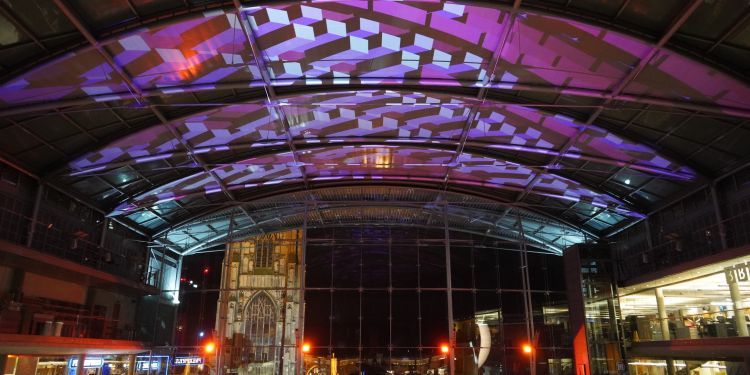Breadcrumb navigation
In Conversation with Angeline Ferguson, Video Design Lecturer at Guildhall School

Angeline Ferguson, Video Design Lecturer at Guildhall School, talks about video projection mapping and how it might be a career of opportunity.
Angeline has worked with the likes of Aardman Animation, BBC Learning, Tate Galleries and History Royal Palaces. Her experience includes designing video projections for many large events and theatre performances. She currently teaches on the undergraduate Production Arts degree at the school.
What does video projection mapping mean?
Video projection mapping is the technique of projecting video onto a physical surface, such as a building or a stage set, with video content that has been designed to fit and work with the structure. It can be done using an array of several projectors networked together to create a large projection; for example, an entire building or event stage. Alternatively, and more simply, just one projector can be used on a smaller stage set or art installation. ‘Mapping’ is the technique of shaping the projection to make it appear to seamlessly fit to work with the structure.
How did you get into it?
I’ve always been fascinated by projection systems and the way light can transform a physical space. In the 90s I experimented with video technology and stop motion film techniques. At the same time, I started going to clubs and large music events, offering to film them. Over time I built a network within the music scene and sold the idea of adding screens with visuals, mixed live, into the clubs and large-scale events. From there, it snowballed, and I created music videos and visuals for all types of live performances including theatre productions, corporate events and touring shows.
Any tips for finding inspiration?
Visit galleries, watch live performances, follow people whose work inspires you. For me, music, art, technology and nature are big sources of inspiration. I love browsing flea markets and charity shops for things. Over the years I’ve built quite a collection of vintage magazines, fabrics and objects that I use in my work. Keep notebooks and sketchbooks to record ideas and doodle your thoughts.
What does a career in video projection mapping look like?
There are many paths to be taken within the industry as video mapping is an increasingly in-demand skill across many parts of theatre, entertainment, film and marketing industries. The roles involved and the size of the teams vary depending on the job. There’s the creative team who work on content and the technical team who are responsible for the set-up.
Video designers work with animators to create content while video engineers configure the technical set-up. This involves site visits to calculate the number of projectors, lens sizes to use, and where to rig them.
There’s no such thing as a typical day because it depends on the scale and budget of the project, and your role.
Do you have a career highlight?
Truly every project has highlights, especially when you see the work take shape in or on a space. Often, we work for months on a project using only photographs, 3D models or scans of the projection site, so when it all comes together in situ it’s an amazing buzz. And then on top of that, seeing people’s reactions to it is a truly rewarding experience.
Angeline leads the five-day Summer School Introduction to Video Projection Mapping from 25 July.
Want to know more about studying video projection mapping at Guildhall? Speak to our tutors at one of our June Production Arts Degree Open Events. Book your place here.
Photograph of video projection created by Guildhall School of Music & Drama students, with support from Guildhall Live Events.